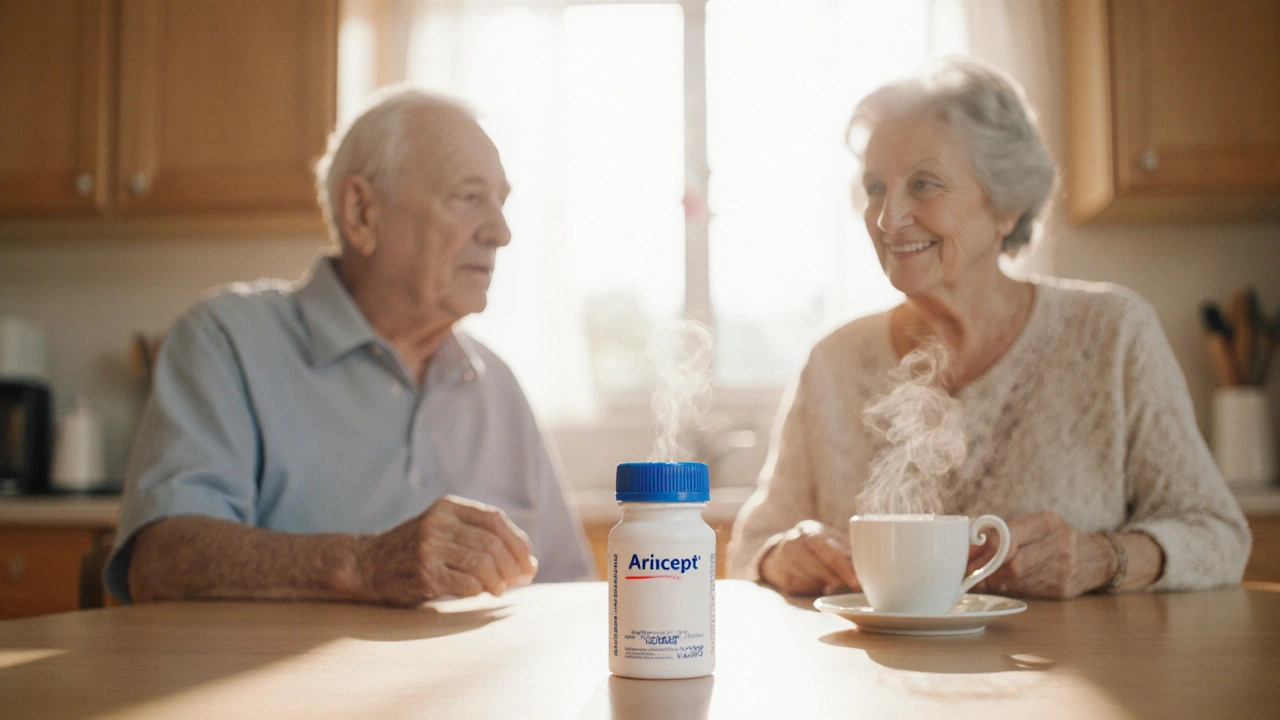Alzheimer's Drug Comparison Tool
Compare Alzheimer's Medications
Select a medication below to see detailed information about its mechanism, dosage, benefits, and side effects.
Key Takeaways
- Aricept (donepezil) is a cholinesterase inhibitor commonly prescribed for mild to moderate Alzheimer’s disease.
- Rivastigmine, galantamine, and memantine are the main FDA‑approved alternatives, each with distinct mechanisms and side‑effect profiles.
- Choosing the right drug depends on disease stage, tolerability, dosing convenience, and cost considerations.
- Combination therapy (e.g., memantine with a cholinesterase inhibitor) can provide added benefit for moderate‑to‑severe cases.
- Regular monitoring of cognition, activities of daily living, and adverse events is essential regardless of the chosen medication.
What Is Aricept (Donepezil)?
Aricept is a prescription pill taken once daily that belongs to the cholinesterase‑inhibitor class. It works by blocking the enzyme acetylcholinesterase, which breaks down acetylcholine - a neurotransmitter critical for learning and memory. By raising acetylcholine levels in the brain, Aricept can modestly slow cognitive decline in patients with early‑stage Alzheimer’s disease.
How Does Aricept Compare to Other FDA‑Approved Alzheimer’s Drugs?
The market for Alzheimer’s medications currently includes two cholinesterase inhibitors (rivastigmine and galantamine), one NMDA‑receptor antagonist (memantine), and, more recently, a disease‑modifying antibody (aducanumab). Each drug targets a different pathway, produces unique benefits, and carries its own set of risks.
Rivastigmine: A Dual‑Action Inhibitor
Rivastigmine blocks both acetylcholinesterase and butyrylcholinesterase, offering a slightly broader boost to cholinergic activity. It’s available as an oral capsule and a transdermal patch, the latter often chosen to reduce gastrointestinal side effects.
Galantamine: Allosteric Modulation
Galantamine inhibits acetylcholinesterase like Aricept but also positively modulates nicotinic receptors, which may enhance neuroprotective signaling. It’s typically started at a low dose and titrated up over weeks.

Memantine: The NMDA Antagonist
Memantine works by blocking NMDA receptors that become overactive in Alzheimer’s, reducing excitotoxic damage. It’s usually prescribed for moderate to severe disease, either alone or in combination with a cholinesterase inhibitor.
Aducanumab: A Disease‑Modifying Antibody (Controversial)
Aducanumab targets amyloid‑beta plaques, aiming to slow the underlying disease process rather than just symptoms. Its high cost, infusion schedule, and mixed trial results make it a niche option, often reserved for patients eligible for clinical trials or specialized centers.
Comparison Table: Aricept vs. Its Alternatives
| Drug | Drug Class | Approved Indication | Typical Dose | Main Advantages | Common Side Effects | Average Monthly Cost (US) |
|---|---|---|---|---|---|---|
| Aricept (Donepezil) | Cholinesterase inhibitor | Mild‑to‑moderate Alzheimer’s | 5mgdaily → 10mgdaily | Once‑daily dosing, proven efficacy | Nausea, insomnia, muscle cramps | $90‑$130 |
| Rivastigmine | Dual cholinesterase inhibitor | Mild‑to‑moderate Alzheimer’s; Parkinson’s dementia | Oral: 1.5mgbid → 6mgbid; Patch: 4.6mg/24h | Patch reduces GI upset | Vomiting, skin irritation (patch) | $100‑$150 |
| Galantamine | Cholinesterase inhibitor + nicotinic modulator | Mild‑to‑moderate Alzheimer’s | 4mg tid → 8mg tid → 12mg tid | Potential cognitive boost via nicotinic action | Dizziness, loss of appetite | $120‑$160 |
| Memantine | NMDA receptor antagonist | Moderate‑to‑severe Alzheimer’s | 5mg tid → 20mg tid | Improves function in later stages, can be combined | Headache, constipation, dizziness | $75‑$110 |
| Aducanumab | Monoclonal antibody (amyloid‑targeting) | Early Alzheimer’s (FDA accelerated approval) | IV infusion: 1mg/kg → 10mg/kg (monthly) | Potential disease‑modifying effect | ARIA‑E (edema), infusion reactions | $4,800‑$5,600 |
When Might Aricept Be the Right Choice?
Aricept shines in patients who need a simple, once‑daily regimen and are in the early phases of cognitive decline. Its side‑effect profile is relatively mild compared with rivastigmine’s GI issues, but clinicians should monitor for insomnia and muscle cramps, especially at the 10mg dose.
Key scenarios:
- Newly diagnosed mild Alzheimer’s with good hepatic function.
- Patients on multiple medications where adding a twice‑daily drug could increase complexity.
- Individuals who prefer oral tablets over patches or infusions.
When Alternatives May Edge Out Aricept
Every drug has a niche. Here’s where the others may be preferable:
- Rivastigmine patch for patients who experience severe nausea on oral cholinesterase inhibitors.
- Galantamine when clinicians suspect nicotinic‑receptor deficits may contribute to symptoms.
- Memantine for moderate‑to‑severe disease or when combining with a cholinesterase inhibitor for additive effect.
- Aducanumab for patients in specialized centers who can afford high out‑of‑pocket costs and meet strict MRI monitoring criteria.

Practical Checklist for Clinicians & Caregivers
- Confirm diagnosis and disease stage (mild, moderate, severe).
- Review current medications for potential drug‑drug interactions.
- Discuss dosing schedule preferences (once‑daily vs. twice‑daily vs. patch).
- Assess baseline labs: liver enzymes, renal function, ECG if needed.
- Start with the lowest effective dose; titrate slowly to minimize side effects.
- Schedule follow‑up at 4‑6 weeks to evaluate cognition (MMSE or MoCA) and tolerability.
- Consider adding memantine if progression continues after 6 months on a cholinesterase inhibitor.
- Document cost considerations; check insurance formularies and patient assistance programs.
Cost & Insurance Realities in 2025
Pricing data from 2024 shows a narrow gap between the three cholinesterase inhibitors, while memantine is modestly cheaper. Aducanumab remains prohibitively expensive for most patients, and many insurers still require prior authorization or limit coverage to clinical‑trial participants.
Patients often benefit from manufacturer coupons, Medicare Part D step therapy, or state drug‑assistance programs. Always verify the most recent formulary before prescribing.
Monitoring & Safety Tips
Regardless of the chosen drug, regular monitoring is crucial:
- Track weight, appetite, and bowel habits to catch GI toxicity early.
- Review sleep patterns; cholinergic agents can cause vivid dreams.
- Run liver function tests every 3‑6 months for rivastigmine and galantamine.
- For aducanumab, obtain baseline MRI and repeat every 3 months to detect ARIA.
Bottom Line: Personalize the Choice
There’s no one‑size‑fits‑all Alzheimer’s drug. Aricept offers convenience and a well‑documented efficacy record for mild cases, but rivastigmine, galantamine, and memantine each bring advantages that align with specific patient profiles. A thoughtful assessment of disease stage, side‑effect tolerance, dosing preferences, and cost will guide the optimal regimen.
Frequently Asked Questions
Can I switch from Aricept to another cholinesterase inhibitor?
Yes. Switching is common if side effects become intolerable. A typical approach is a brief washout (usually 1‑2 days) followed by the new drug at its starting dose. Always involve a physician to monitor the transition.
Is it safe to combine Aricept with memantine?
Combining a cholinesterase inhibitor with memantine is FDA‑approved for moderate‑to‑severe Alzheimer’s. Clinical trials show modest improvements in daily functioning. Coordination with a neurologist is recommended to manage dosing and side effects.
Why does the Aricept patch not exist?
Aricept is formulated for oral absorption; the drug’s pharmacokinetics aren’t compatible with transdermal delivery. Rivastigmine, however, has a patch version because its chemical properties allow steady skin absorption.
What should I do if my loved one experiences severe nausea on Aricept?
First, contact the prescribing clinician. They may lower the dose, split the tablet (if capsule form), or switch to an alternative like the rivastigmine patch, which bypasses the GI tract.
Is aducanumab covered by Medicare?
Medicare Part B covers infusion costs, but patients often face high out‑of‑pocket expenses after deductibles. Coverage varies by plan, and many insurers require enrollment in a clinical‑study protocol.


Michael Barrett
October 10, 2025 AT 18:24When we contemplate the pharmacological landscape of Alzheimer’s disease, we are in fact peering into the very architecture of memory itself; the choice of a cholinesterase inhibitor is not merely a clinical decision, but a metaphysical one. Aricept, as the archetypal donepezil, offers the elegance of once‑daily dosing, a feature that aligns with the human desire for simplicity in the midst of cognitive fog. Yet simplicity should not blind us to the nuanced interplay of acetylcholine dynamics, which reverberate through synaptic clefts like ancient echoes. Rivastigmine, by inhibiting both acetylcholinesterase and butyrylcholinesterase, expands the cholinergic canvas, promising a broader neurotransmitter modulation, though at the cost of a more complex dosing regimen. Galantamine adds a layer of nicotinic receptor allosterism, an elegant twist that suggests we can coax the brain not only by preventing breakdown but also by enhancing reception. Memantine, occupying the NMDA receptor niche, reminds us that excitotoxicity is a parallel villain in the neurodegenerative saga, a fact often underappreciated by those fixated on cholinergic pathways. Aducanumab, with its monoclonal antibody bravado, attempts to rewrite the story at the amyloid level, yet its price tag and controversial efficacy raise ethical questions that no pharmacologist can ignore. One must also weigh the side‑effect profiles: nausea and insomnia from Aricept contrast sharply with the dermatologic concerns of the rivastigmine patch, and the dizziness of galantamine can be a deal‑breaker for the elderly. Cost, of course, is the ever‑present specter; a monthly outlay of $90–$130 for Aricept pales in comparison to the five‑thousand‑dollar range demanded by aducanumab. Insurance formularies, prior authorizations, and patient assistance programs become the bureaucratic scaffolding upon which therapeutic choices rest. Moreover, the timing of titration-whether a gradual escalation of donepezil from 5 mg to 10 mg or a swift jump-can dictate tolerability and adherence. Clinical guidelines advocate a patient‑centered approach, integrating caregiver preferences, comorbidities, and hepatic function into the algorithmic decision tree. In practice, the combination of a cholinesterase inhibitor with memantine for moderate‑to‑severe disease exemplifies the synergy principle, delivering modest gains in activities of daily living. Finally, regular neuropsychological assessment using tools such as MMSE or MoCA provides the feedback loop necessary to adjust therapy, lest we wander blindly in a sea of speculation. Thus, the selection of Aricept versus its alternatives is a multidimensional calculus, where efficacy, safety, convenience, cost, and philosophical conviction must all be balanced.
Inma Sims
October 11, 2025 AT 11:04While your treatise eloquently maps the entire therapeutic cosmos, I assure you that most clinicians simply glance at the cost column and choose whichever fits the insurance sweet spot.
Gavin Potenza
October 12, 2025 AT 03:44Honestly, I've seen patients flip‑flop between donepezil and the rivastigmine patch like they're changing shirts; the key is really how each tolerates the gut. If nausea hits hard, the patch can be a lifesaver, and if skin irritation is the issue, back to a pill. It's all about trial and error, not some grand philosophical doctrine.
Virat Mishra
October 12, 2025 AT 20:24People think swapping pills is trivial but it reveals their moral failure to care for the vulnerable. The drama of dosage changes should wake us.
Daisy Aguirre
October 13, 2025 AT 13:04Hey folks, navigating Alzheimer’s meds can feel like climbing a rainbow‑colored mountain, but remember you’re not alone! 🎉 Embrace the simplicity of Aricept if you crave a once‑daily routine, and celebrate every small win-whether it’s a calmer night or a brighter morning. If side effects loom, explore the patch or galantamine; there’s a palette of options to paint a better quality of life. Keep the conversation upbeat, stay hopeful, and lean on your support network.
Natalie Kelly
October 14, 2025 AT 05:44Totally agree keep it simple thx.
Tiffany Clarke
October 14, 2025 AT 22:24All this feels exhausting.
Sandy Gold
October 15, 2025 AT 15:04I must interject here and point out that the entire comparison chart is a bit of a fluff piece, frankly. While the author lists costs and side‑effects, they conveniently ignore the real‑world adherence data that shows many patients discontinue donepezil within months. Moreover, the claim that memantine “improves function” is inflated; most studies show only modest benefits over placebo, not the miracle cure you’d expect. The patch for rivastigmine is praised, yet skin irritation rates are higher than reported in the table. And let’s not gloss over the fact that aducanumab’s “potential disease‑modifying effect” is still under heavy debate among neurologists. In my experience, the most reliable metric is caregiver burden, which the article never quantifies. Also, the dosing schedules are oversimplified-up‑titration of donepezil can be slower for patients with hepatic issues, something the chart glosses over. The cultural nuance of patient preference, especially in non‑Western settings, is missing, making the guide feel US‑centric. Cost analysis is also outdated; generic donepezil prices have dropped significantly in the past year. Finally, the author could have mentioned the emerging biosimilar antibodies that might soon challenge aducanumab’s market share.
Frank Pennetti
October 16, 2025 AT 07:44The analysis you present is riddled with hyperbole and lacks empirical rigor; you’re essentially peddling anecdotal bias under the guise of critique. In the domain of neuropharmacology, we must adhere to evidence‑based metrics rather than speculative narratives. Your omission of pharmacokinetic parameters, such as Cmax and half‑life, undermines any semblance of credibility.
Adam Baxter
October 17, 2025 AT 00:24Let’s keep pushing forward with optimism.
Keri Henderson
October 17, 2025 AT 17:04Your positivity is contagious and exactly what caregivers need right now.
elvin casimir
October 18, 2025 AT 09:44Frank, you’ve got some valid points but note the phrase “peddling anecdotal bias under the guise of critique” should be “peddling anecdotal bias under the guise of critique.” Also, “pharmacokinetic” is spelled correctly; ensure consistency.
Steve Batancs
October 19, 2025 AT 02:24From a national perspective, it is crucial that our healthcare system prioritizes affordable, domestically produced Alzheimer's therapies rather than relying on exorbitant imported biologics. The emphasis should be on supporting local pharmaceutical innovation while ensuring patients receive evidence‑based treatments. Policy decisions must reflect both fiscal responsibility and clinical efficacy.